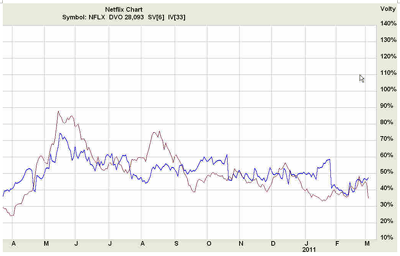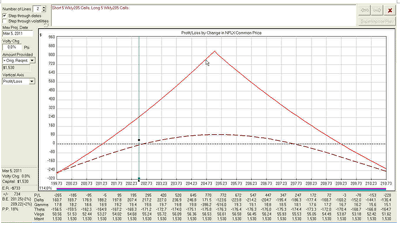A trader reviews the three key forces that drive the options market, and using a recent winning trade as an example, shows how a calendar spread trade was identified and executed.
By J.W. Jones
When considering the specific architecture of the various option trades that occupy an option trader's day, the overriding consideration is to put as many factors at your back as possible. Remember that the trades are impacted by the three primal forces of the option traders' world: Price of the underlying, time to expiration, and implied volatility. Trades designed to maximize the positive effect of each of these variables have a much higher probability of success.
One commonly used strategy is that of a calendar spread. This position is constructed by selling one shorter-dated option and buying a longer-dated option at the same strike. The calendar may be constructed in either puts or calls, but each individual calendar consists of the same type of contracts-either puts or calls-not a mixture of both.
The profit engine for this trade is the differential rate of decay of the time component (extrinsic value) of an option. Remember that the time premium of all options goes to zero at the time of their expiration. Furthermore, an essential characteristic of all options is that time decay is not linear; the decay of time premium of shorter-dated options occurs at a much more rapid pace than does the decay of longer-dated options.
In the appropriate environment, calendar spreads can offer outstanding risk/reward trades. What is the environment in which calendar trades prosper? It is the environment of low implied volatility. How does a trader decide what is a low volatility environment? He must consider the situation in the specific underlying for which he is considering a trade.
Many traders are aware of the VIX, which is the implied volatility reflective of the broad-based SPX index. However, databases from various vendors are available and track the implied volatility of specific underlyings. Incorporation of the current value of these volatility measures is essential to ensuring the success of a variety of trade structures, but it is especially important in calendars.
An example of the type of chart that the successful option trader needs to consider is illustrated below. Note that statistical volatility, or the volatility calculated from the historical behavior of price, is displayed in brown. The implied volatility, which is the critically important variable for option traders, is displayed in blue. We will return to this chart in a moment, but for now, notice the current relationship of the blue line to its recent position.
The time frame over which calendars have historically been used is from one month to another; for example, a March-April calendar spread. Profit accrual in these monthly calendars has historically been quite slow and steady over a wide range of prices.
However, the recent availability of weekly options has provided traders with "warp speed calendars." Let us consider an example of such a trade and how appropriate selection of vehicles can put the wind at our backs.
Thursday morning, I noticed a chart pattern that I felt suggested a high probability that Netflix (NFLX) would trade higher over the day. In considering and modeling various possible structures for a short-term trade, I was struck by a very favorable risk/reward scenario for this stock within the structure of a calendar trade.
The favorable components were:
- Availability of very liquid weekly options that would expire the next day and a week from the next day
- The existence of substantial time premium in the options with 30 hours to expiration
- Reasonable implied volatility within the options in which I was considering a trade, and the fact that these volatilities were the same in both the short- and longer-dated options at a value of 43%
The trade was initiated at approximately 9:30 am and at the time of inception had the following P&L graph:
Price remained within the profitable zone reflected in the graph above, and the trade was removed a few minutes before the closing bell for a total profit of slightly over 10% of invested capital. The primary profit engine was the decay of time premium within the short option leg.
Opportunities such as this are routinely available for the knowledgeable options trader. Such opportunities are not available for long periods of time and must be taken as they present themselves. It is for this reason that traders who wish to benefit from such trades must be prepared in advance with the knowledge of options behavior.
By J.W. Jones of OptionsTradingSignals.com












